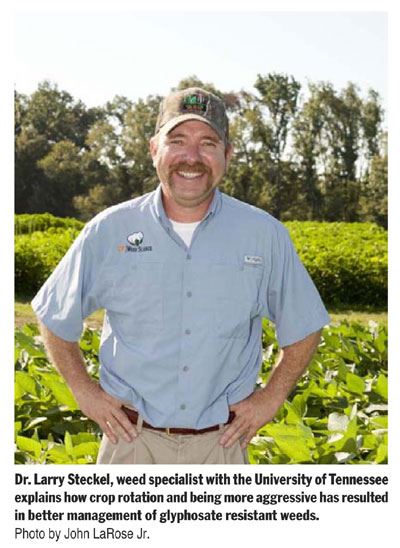Hit Resistance HARD
To Control Resistance, Farmers Must Use All Tools In The Toolbox
MILAN, TENN.
“We are doing a better job managing our glyphosate resistant weeds particularly Palmer pigweed last year compared to 2011 in the state and there’s a number of reasons for that,” said Dr. Larry Steckel, weed specialist with the University of Tennessee.
“Number one, we have rotated more into corn and Palmer pigweed is a lot easier to manage in corn than it is in soybeans so that’s been a real positive. Number two folks are being a little bit more aggressive going out and managing pigweeds in their soybeans and cotton,” he added.
Farmers are controlling resistance in a number of different ways. More LibertyLink crops are being grown, and farmers have rotated to Liberty Link crops particularly in cotton, but also in soybeans. Liberty is doing a very good job if it is applied timely. Liberty is controlling one to two inch pigweed, and some even up to five inches. However, a second application of Liberty is often needed if the Palmer is 4 inches tall or more at the first application timing.
“Whether it’s Roundup Ready crops, LibertyLink crops or conventional crops, folks are using multiple residual herbicides,” Steckel commented.

Last summer wasn’t a real good year for using residual herbicides and getting them activated. In a lot of cases farmers were at least getting one activated and that provided a little time to get out and get post emergence applications of Flexstar, Blazer, Cobra more timely than the applications in 2011. That’s been a real positive.
“Also, folks are going out with chopping crews and cleaning up escapes, trying to keep some of these pigweeds that are slipping through from producing seed and being a problem in next year’s crop,” Steckel added. “Really it’s going to take all those tools going forward to manage these weeds. You have to use some different herbicides, different herbicide technologies, sequential applications, crop rotations, and then just clean up fields afterwards, whether it’s with a hooded sprayer or going out with some chopping crews and doing some supplemental chopping.”
Steckel also hit on some of the newer technologies that are coming in the future, especially the pyroxasulfone product, which hopefully will be labeled in soybeans this next year. Three different companies will sell it by itself; the herbicide by itself is going to be called Zidual from BASF. Valent will offer it as a premix with Valor and call it Fierce, and FMC will offer it as a pre-mix with Cadet and call it Anthem.
“That’s a good small seeded broadleaf residual compound very similar to Dual and it’s going to be another good tool to have in the toolbox,” he said.
In a year or two, companies are coming out with some of the new technology traits. The Dicamba trait from Monsanto, the 2,4-D trait from Dow, will be very good tools to help manage pigweeds.
“When they get here, we’re going to be better off managing those weeds with them than we are currently today because, especially in the Roundup Ready system; it’s a real struggle to control any pigweed three to four inches tall, but these new technologies, whether it’s 2,4-D or dicamba we’ll be able to manage those much easier,” Steckel added.
“I don’t want folks to get the thought that we’re just going to be able to go back to Roundup Ready 2003; nothing unfortunately is going to be that simple and easy,” he said. “We’re still going forward even with these new technology traits, we’re still going to have to use all the tools in the toolbox to manage weeds.
“So again, crop rotation, using residuals, overlaying those residuals, in some cases getting cultivators out, in other cases getting chopping crews out, using hooded sprayers, and we even have some folks looking at implementing some cover crops in some cases. So I think we’re going to have to use all these tools going forward to help manage pigweed from now and into the future,” he summed. Δ
BETTY VALLE GEGG-NAEGER: Senior Staff Writer, MidAmerica Farmer Grower